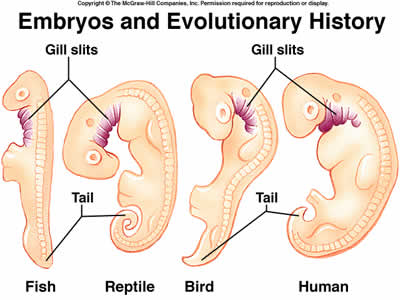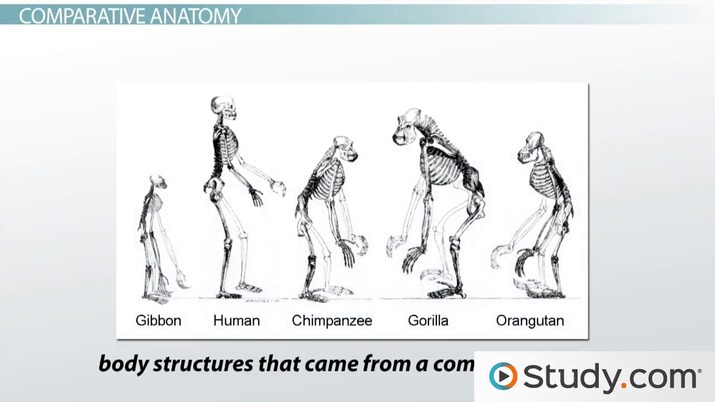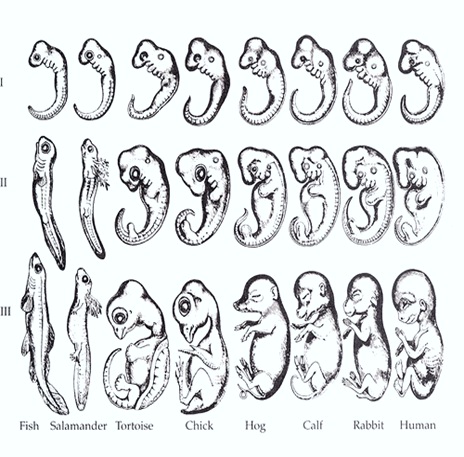The truth is as you might expect that the biogeographic distribution of species supports evolution. Embryos of many different kinds of animals.
Https Www Peekskillcsd Org Cms Lib Ny01913880 Centricity Domain 827 Evidence For Evolution Factsheet1 Pdf
Scientists have used comparative embryology to study and gather evidence of evolution.
How does embryology support evolution. The gill slits are not gills however. For example in humans the embryo passes through a stage in which it has a gill structure similar to that of fish. Human embryos also have a tail much like other primates though the tail is usually re-absorbed before birth and this suggests that even though their adult forms are different these.
These are structures shared by related organisms that were inherited from a common ancestor. Other evidence is provided by analogous structures. Embryology provides evidence for evolution since the embryonic forms of divergent groups are extremely similar.
Scientists compare the anatomy embryos and DNA of living things to understand how they evolved. How Embryology Does Not Prove Evolution Evolutionists have speculated embryos replay the evolutionary history of their species as they develop - but this is demonstrably false. The natural distribution of species across different continents supports evolution.
Evidence for evolution is provided by homologous structures. Elizabeth Mitchell on September 5 2020 Featured in The New Answers Book 4. Embryology Another difficulty in comparing traits between species rests on the fact that homologous.
See the diagram below. Mammals birds reptiles fish etc. In humans those turn into our ears.
In a fish those develop into gills. Evidence for Evolution quizzes about important details and events in every section of the book. Studying these early stages in multiple animals can help us learn about how different species may have evolved through time.
Look very similar and it is often difficult to tell them apart. Embryology is an important cornerstone of biological evolution and can be used to help determine similarities and differences between various species. An example of vestigial embryonic structure that supports evolution is the vestigial yolk sac of human and other eutherian embryos.
Embryology looks at the very early stages of development in animals. The study of one type of evidence of evolution is called embryology the study of embryos. Not only is embryology used as evidence of the theory of evolution and the radiation of species from a common ancestor but it also can be used to detect some types of diseases and disorders before birth.
The greater the similarity in structure the more closely related the species are and the more recent their common ancestor is. I think q p r s but don blame me because im no a 100 sure. Some statements - direct or indirect - on this.
When you hear talk of evidence for evolution the first thing that frequently comes to mind for most people is fossilsThe fossil record has one important unique characteristic. How does embryology support evolution. For example all vertebrate embryos have gill slits and tails as shown in Figure below.
Species that evolved before the breakup of the supercontinent are distributed worldwide whereas species that evolved more recently are more localized. Species are distributed around the globe largely in relation to their genetic relationships to one another with some understood exceptions. Comparative embryology supports the theory of evolution because scientists have found that the embryos of many different species show similarities which implies they share a common origin.
Similarities during the stages of embryonic development help scientists classify organisms in a taxonomy. Embryology is used in evolution because its shows a common For example a human and fi sh have similar embryos. From what Ive learned in biology embryology proves our modern theory of evolution by the similar structures found in embryos.
There are many hidden dangers that make it necessary to support evidence from comparative anatomy with evidence from other fields of study. Karl Ernst von Baer a Russian scientist made observations on embryos of different species and came up with four principles of comparative embryology. Embryology proves evolution to be true because all embryonic cells look alike no matter what the species.
Science itself is constantly evolving and offering us more information as to how we and all other creatures on our planet have evolved and grown over time. Like adults embryos show similarities which can support common ancestry. Comparative Embryology - Evidence for Evolution.
An embryo is an unborn or unhatched animal or human young in its earliest phases. It is our only actual glimpse into the past where common descent is proposed to have taken place. In fact early-stage human embryos have a tail and rudimentary gills like a fish.
Embryology is a branch of comparative anatomy which studies the development of vertebrate animals before birth or hatching. Studies of embryology and evolution support Charles Darwins theory of evolution of life from a common ancestor. The theory of evolution has come a long way since Darwin published his theory back in 1859 mainly due to the fact that scientists are able to study organisms in a way that was never possible in the past.
Comparative embryology is the study of how different types of organisms compare to each other during their fetal stages.
 What Is Comparative Embryology
What Is Comparative Embryology
 Seventh Grade Lesson Embryonic Development Evidence For Evolution
Seventh Grade Lesson Embryonic Development Evidence For Evolution
 Pin By Bill Manning On Innovate To Transform Spring 2014 Course Assignment Evidences Of Evolution Life Hacks For School Theory Of Evolution Evolution
Pin By Bill Manning On Innovate To Transform Spring 2014 Course Assignment Evidences Of Evolution Life Hacks For School Theory Of Evolution Evolution
 Does Ontogeny Recapitulate Phylogeny Refuting Embryological Evidence For Evolution Across The Fruited Plain
Does Ontogeny Recapitulate Phylogeny Refuting Embryological Evidence For Evolution Across The Fruited Plain
 How Does Embryology Support Evolution Study Com
How Does Embryology Support Evolution Study Com
 How Does Embryology Prove Evolution Socratic
How Does Embryology Prove Evolution Socratic
 Seventh Grade Lesson Embryonic Development Evidence For Evolution
Seventh Grade Lesson Embryonic Development Evidence For Evolution
Comparative Embryology Evidence For Evolution
 Evolutionary Embryology Developmental Biology Microbe Notes
Evolutionary Embryology Developmental Biology Microbe Notes
 Embryological Evidence Of Evolution Summary Examples Expii
Embryological Evidence Of Evolution Summary Examples Expii
 Embryological Evidences For Organic Evolution
Embryological Evidences For Organic Evolution
